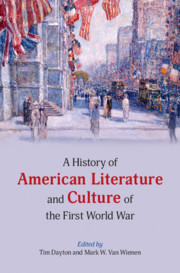Book contents
- A History of American Literature and Culture of the First World War
- A History of American Literature and Culture of the First World War
- Copyright page
- Contents
- Figures
- Contributors
- Acknowledgments
- Introduction America’s Great War at One Hundred (and Counting)
- Part I Genre and Medium
- Part II Settings and Subjects
- Chapter 9 The Peace Movement
- Chapter 10 Americans in France
- Chapter 11 German Americans
- Chapter 12 The English in America
- Chapter 13 Preparedness
- Chapter 14 Propaganda
- Chapter 15 Conscientious Objectors
- Chapter 16 Volunteers
- Chapter 17 African Americans
- Chapter 18 In the Midwest
- Chapter 19 In the South
- Chapter 20 Revolution
- Chapter 21 Monuments and Memorials
- Part III Transformations
- References
- Index
Chapter 15 - Conscientious Objectors
Conscience, Courage, and Resistance
from Part II - Settings and Subjects
Published online by Cambridge University Press: 23 January 2021
- A History of American Literature and Culture of the First World War
- A History of American Literature and Culture of the First World War
- Copyright page
- Contents
- Figures
- Contributors
- Acknowledgments
- Introduction America’s Great War at One Hundred (and Counting)
- Part I Genre and Medium
- Part II Settings and Subjects
- Chapter 9 The Peace Movement
- Chapter 10 Americans in France
- Chapter 11 German Americans
- Chapter 12 The English in America
- Chapter 13 Preparedness
- Chapter 14 Propaganda
- Chapter 15 Conscientious Objectors
- Chapter 16 Volunteers
- Chapter 17 African Americans
- Chapter 18 In the Midwest
- Chapter 19 In the South
- Chapter 20 Revolution
- Chapter 21 Monuments and Memorials
- Part III Transformations
- References
- Index
Summary
This chapter explores the 4,000 conscientious objectors (COs) who refused to kill during World War I. It examines the Selective Service Act of 1917 and the religious and secular principles that led men to become COs. By refusing military combat service and resisting the military rules in army camps and military prisons that violated their conscience, COs demonstrated courage, sacrifice, and commitment to principle. Although most COs accepted noncombatant military service or alternative civilian service, 450 absolutists, who refused to cooperate with military authorities and rejected all service under military control, were court-martialed and imprisoned. In camps and prisons, COs defied military rules, regulations, and policies. Their resistance included refusal to obey orders, work strikes, hunger strikes, general strikes, noncooperation, and nonviolent revolts. Furthermore, COs were often severely abused, which led to a wartime civil liberties movement that defended (and which included) COs and that evolved into the postwar American Civil Liberties Union. Finally, this chapter shows how COs contributed to peace and freedom by advancing civil liberties, inspiring future COs, liberalizing World War II conscription legislation, secularizing the peace movement, and pioneering the nonviolent direct action that infused post-1945 peace and justice movements.
Keywords
- Type
- Chapter
- Information
- Publisher: Cambridge University PressPrint publication year: 2021

